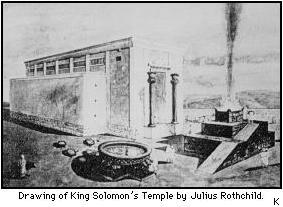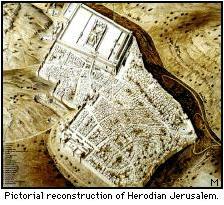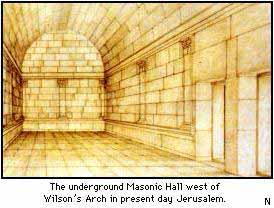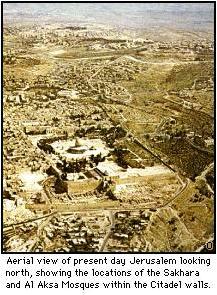









 |
 |
|
 |
 |
|
 |
 |
Freemasonry in Israel |
 |
 |
|
 |
 |
|
|
| The Origin and Fate of the Temples at Jerusalem Philip E.H. Thomas |
• 965 BCE
Solomon succeeded David as King of the United Israelite Kingdom of the Twelve Tribes. Taking their names and territories from north to south, they were:
Israel: Dan (north & south), Naphtali, Asher, Zebulun, Levi or Manasseh (east & west), Issacher, Gad, and Joseph or Ephraim.
Judah: Benjamin, Judah, Reuben and Simeon (18).
• 964 BCE

Solomon ordered the start of preparations for the construction of the First Temple. Hiram, King of Tyre, a good friend of both he and his father, had already volunteered to provide all the timber such as cedar, pine and olive wood from the Lebanon in return for food for his own people and the gift of 20 small townships near the Sea of Galilee (19). The two kings sealed their agreement with prayers together on Mount Moriah.
Solomon conscripted 30,000 foreign labourers to help Hiram. He also mustered 120,000 slaves to quarry and move the stone. This forced labour was under the overall direction of Adoniram, who was assisted by 3,300 supervisors. Only 550 Israelites were engaged on the project. They held positions of management and control of whom Adoniram was one. Whilst he may have been a stone mason by trade, he was first and foremost King Solomon's slave master (20). About 30 years later, and after Solomon had died, Adoniram was stoned to death for unrecorded reasons.
• 960 BCE

With the foundations in place, the structure took shape in the form of three sections: the porch or vestibule, or 'Ulam', was outside the Temple proper and faced east. It led, via the main entrance, into the body of the Temple, or 'Hekhal'. The Holy of Holies, or 'Debir', occupied one third of the Temple furthest from the main entrance. The combined internal measurements of the 'Hekhal' and 'Debir' were about 90 feet (27 m) long, 30 feet (9 m) wide and 40 feet (12 m) high. However, the floor of the Debir was raised about 10 feet (3 m) so that this chamber then formed a perfect cube of about 30 feet (9 m). A frontal staircase gave access to it. There may also have been a room underneath, but this is unconfirmed.
The Ark was to be positioned in the centre of the Debir, flanked by two large wooden gold-plated winged Cherubim. The whole of the Holy of Holies, or Sanctum Sanctorum, was to be shrouded from public view by linen curtains coloured red, blue and purple.
The walls of the Temple were constructed in an unusual manner. First were laid three courses of dressed stone, followed by one layer of interlocking cedar beams or ties, then another three courses of dressed stone, followed by another layer of timber, and so on (21). It has been suggested that the reason for this was to make the structure better able to withstand the occasional earth tremors in that region. (The second Temple was built similarly) Indeed, even today, many buildings between eastern Turkey and Afghanistan are built this way. Surprisingly, it is only in the last half of this century that this principle of structural elasticity, in respect of large buildings, has been re-adopted. It is now in widespread use in California and Japan.
Interconnecting annexes, established upon three floors, abutted three sides of the Temple. There were approximately 30 such rooms, each with one or more slitted windows to enable use by archers if defence was needed. None of these rooms had any access to the Temple itself: their entry was gained via doors and stairs let into each side of the porchway. The Temple itself had its own single entrance via the vestibule. There were never three entrances to the Temple itself, although there may well have been such entrances to the Temple precinct.
Initially, all stonework within the Temple, as well as that outside the whole structure, was clad completely in wooden panelling. The roof itself was almost flat, supported by joists of cedar which, in turn, were supported by seven pairs of pillars.
The reported absence of the use of metal tools in the construction of the Temple edifice has never been made clear; i.e. whether it was purely the lack of sound, or whether no metal tools at all were used. If the latter, it would have necessitated the preparation of timber beams and panelling well away from the site. Obviously metal tools had to be used in the underground quarry where, naturally, no noise would have been audible on the surface.
• 958 BCE

When the structure was nearing completion, Solomon invited a skilled foundryman from Tyre to embellish the Temple with gold, silver and bronze metal-work (22). Although he was called Hiram, ostensibly of the tribe of Naphtali, Freemasons have, over the last three centuries, come to know him as Hiram Abif. However, nowhere in the Old Testament does that name appear in this form. The origin of 'Abif' itself is unknown and about which there is still much speculation. A widely accepted view is that 'Hiram Abif' could be a translating corruption of the Hebrew 'Huram abi', namely 'the son of Huram'. At all events, he was never an architect, nor was he ever involved in the actual construction of the Temple, as has been commonly believed. On the other hand, the genius that he displayed in the scale and beauty of his craftsmanship, earned him a special relationship with Solomon.
Using the great clay pits at Succoth on the east side of the Jordan Valley, 60 miles (100 km) northeast of Jerusalem, Hiram cast two great hollow pillars in bronze (each 25 feet (8 m) high and six feet (2 m) in diameter) and adorned them with capitals in the shape of huge bowls seven feet (2 m) deep, ornately decorated, and each rimmed with two rows of 100 pomegranates. These columns were erected and stood alone on either side in front of the vestibule at the east end of the Temple. Hiram named them 'Boaz' on the right (north) and 'Yachin' on the left (south), as viewed from outside the entrance.
He then cast a bronze circular cistern 15 feet (4.5 m) in diameter and with sides three inches (7.5 cm) thick, capable of holding 10,000 gallons (37,800 litres) of water, which he mounted upon twelve life-size bronze bulls. The whole structure was assembled opposite the Southeast corner of the Temple, and referred to as the 'Molten Sea' or 'Laver' (23). Its purpose was to provide the priests with ample water, obtained initially from the deep and large underground cisterns which had been recently excavated to supply the future citadel. Some of these cisterns still exist. Although two streams ran down either side of Mount Moriah, it was the larger one in the Kidron Valley, and which was augmented by water from the Gihon Spring, that provided the main supply to the cisterns by means of a series of tunnels and siphons.
Hiram then went on to erect a huge sacrificial altar in bronze, measuring 30 feet (9 m) square at the base and tiered to a height of 15 feet (4.5 m). Ten very large wheeled basins, together with numerous bronze lamp stands, sacrificial implements, and chariots were added. All this metal-work was heavily embellished with decorative embossing. Added to which, Hiram created an altar in gold for the Holy of Holies, as well as all plating, ornaments, lamps, jars, etc.; each beautifully worked in solid gold and silver. But above all, the surfaces of the whole edifice, both inside the Temple and outside, were clad with gold sheeting so that no part of the basic structure was evident.
There is no known record of the vast quantities of gold, silver, bronze and precious stones that were used (24), although rough calculations have suggested that about 20 tons (20.3 tonnes) of gold alone were utilised. At all events, it must have presented a stunning spectacle that would have been visible for miles around. Incidentally, there is no known record of the fate of Hiram Abif.
• 957 BCE

Palestine (as erroneously named by the Romans) around the first and second millennia BCE was fertile and well wooded. Yet, with a supposed Israelite population by now of about half a million, one might reasonably suspect an element of exaggeration in the accounts of the dedication of the Temple to which large numbers of the populace were witness. It was reported that a sacrifice of 22,000 head of cattle and 120,000 sheep took place (25).
It is perhaps interesting to note that appreciable deforestation occurred at the time of the Roman occupation. This was further exacerbated by the utterly indiscriminate and total destruction of the forests during the period that the Levant was within the Ottoman Empire (c. CE 1300-1700). The result was that the whole area was reduced to a bare and arid land from which progressive recovery has only been achieved over the last half of the 20th. century.
• 956 BCE
Solomon now continued with the construction of his own palace and the associated quarters for those responsible for the government of the kingdom. This, together with citadel walls and defences, took another 13 years, i.e. until 943 BCE.
• 940 BCE
Disbelieving the reports she had received about Solomon's splendour, the Queen of Sheba travelled 1700 miles (2750 km) from southern Yemen (Aden) on a state visit to see things for herself. It seems she came away greatly impressed (26).
• 931 BCE
Nine years later, Solomon died. His son Rehoboam succeeded him. However, a short while later, the kingdom divided; Rehoboam retained Judah, of which Jerusalem remained the capital. Jeroboam I was chosen to rule over the remaining tribes of Israel (27), which henceforth, at their wish, would include the tribes of Reuben and Simeon.
• 925 BCE
Rehoboam, by now in his fifth regnal year, had been allowing skirmishing parties to raid Egyptian settlements. The pharaoh, Ramesses II (mentioned at the beginning), whom it has since been established was also known as Shishak, decided to punish him by leading his army into Judah. The outcome was that a number of hill towns were destroyed. Jerusalem was captured and about to be treated likewise but, following a plea from Rehoboam, the city was spared in exchange for most of the Temple's moveable treasures (28). Fortunately the Ark was spared and left in place. There now followed a period of relative tranquillity for the next three centuries or so.
• 690 BCE
The two kingdoms remained separate until, by common consent, Hezekiah, who had been King of Judah since 715 BCE, took control of a part of Israel as well. Hezekiah was one of the great kings of the day; his particular forte was the construction of many enormous stone structures, both civil and military. Several still exist. It was he who also extended the complex system of tunnels, siphons and cisterns under Mount Moriah to improve the water supply into Jerusalem.
• 597 BCE
After conquering Syria, Nebuchadnezzar II, King of Babylonia, went on to seize Israel and later Judah. Having successfully laid siege to Jerusalem, he imposed a series of puppet kings to govern it. This unsatisfactory state of affairs continued for the next ten years until the Jews revolted, and Nebuchadnezzar finally decided to crush all remaining resistance.
• 587 BCE
With the revolt suppressed, Nebuchadnezzar's forces sacked Jerusalem itself, stripping the Temple of all its gold sheeting and valuable artefacts. The latter, presumably, having been reproduced over the years to replace those seized by Ramesses II some three centuries previously. The Babylonians then broke up the two pillars, the laver and sacrificial altar before burning down the structure which had stood for over 370 years. They followed this by dismantling the citadel walls so thoroughly that little trace of them was left.
Sometime during this period, the Ark of the Covenant vanished completely, and was never referred to again in the Bible. One is forced to presume either, that this was because it was destroyed or, more intriguingly, because it was secreted away some time during the previous ten years, never to be rediscovered. It seems inconceivable that the High Priest would have passively allowed its capture. Equally, the removal of such a holy artefact, together with the profound religious significance that it exerted, could hardly have passed unnoticed or unrecorded. It is not unreasonable to suspect that it could have been hidden in the depths of Mount Moriah.
On the other hand, Jeremiah, in the Apocrypha, is reported to have stated clearly that he removed and hid the Ark in a cave outside Jerusalem and which he then sealed up (29).
Graham Hancock, in his BBC programme of 8th. August 1993, submitted another theory in that it might have been transported secretly to Aksum, the ancient former capital of Ethiopia. At all events, what ever the answer, its disappearance still remains the greatest Biblical mystery.
• 587 BCE (continued)
As a sequel to pillaging the Treasury, Nebuchadnezzar ordered some 5,000 of the most important and skilled Jews to be taken into exile at Babylon. This was done in four phases, spread over a number of years; the remaining Jews being left to 'till the land' (30). The Old Testament records that King Jehoiachin was taken along with them and subsequently released by the new Babylonish King Evilmoradach after 37 years in a prison (31). This has been questioned, as some now believe that Jehoiachin, aged 18, died in 597 BCE after a brief reign of only three months, and well before the Babylonian invasion. Moreover, Jehoiachin had been succeeded by Zedekiah (Tsidkiyáhu), although eventually the latter was left without authority over Jerusalem and its puppet kings.
Following the abortive revolt later that summer, Nebuchadnezzar, angered by Zedekiah's alleged treachery and ingratitude for past favours, forced the latter to witness the execution of his three sons before his own eyes were gouged out. Zedekiah was then taken into captivity in Babylon where he died soon afterwards in early 586 BCE.
• 539 BCE
There was little love lost between the Persians and the Babylonians: a modern parallel is that between the Iranians and the Iraqis. Cyrus, Emperor of Persia, succeeded in conquering Babylonia and then went on to take Syria, the whole of Israel and Trans-Jordan.
• 538 BCE
With the retaking of Jerusalem, and after almost 50 years in exile, Cyrus allowed the banished Jews to return to rebuild their Temple (32). Moreover, and most handsomely, he ordered the return to the Jews of all the treasures originally plundered by Nebuchadnezzar (33). Again, there was no mention of the Ark.
• 537 BCE

Preparation for the new Temple began. First, however, a more substantial level platform needed to be organised. This necessitated the erection of massive retaining walls, of which some of the stone blocks each weighed nearly 100 tons.
Work on the Temple itself then took shape, based upon a similar but much larger design, although without any annexes. The stone was quarried from beneath the Old City. This was done because of its white colour and fine texture. It has been said that Solomon too had obtained his stone from the same quarry. The quarry still exists underground and access may be achieved via the entrance situated between the Damascus and Herod's Gates. Nowadays, King Solomon's Quarries are used several times a year to conduct Masonic meetings.
Once again the roof was supported by 14 pillars. However, impressive though it was, the structure was not decorated nearly so lavishly as in the days of Solomon, nor were there any pillars at the porch. Recent exploration has revealed that the foundations around the south-east corner went to a depth of 160 feet (50 m) below ground level. It would mean that in those days these massive walls could have been nearly 300 feet (90 m) high in places. This, though, is no longer apparent as, over the centuries, the steep valleys adjoining Mount Moriah have become filled with excavation rubble and building debris so that now they have become quite shallow.
• 514 BCE

After numerous delays, resulting in the work being spread over 23 years, the Second Temple was finally completed and re-dedicated in the reign of Darius I, Emperor of Persia (34). The time lapse between the dedication of the First Temple (957 BCE) and reconstruction of the second Temple (537 BCE) was about 420 years, and not about 500 years as some have contended.
During the latter part of the first century BCE, King Herod the Great (37-4 BCE) enlarged the area of the platform and greatly enhanced the second Temple in an unsuccessful attempt to gain popularity. He created a huge cloistered quadrangle or series of porticos with buildings for both staff and animals. This was further protected by a large fort and tower, later called Antonio. Despite sundry attacks by the Syrians, Greeks and Romans, and interspersed by periods of neglect, the Temple remained functional for nearly 600 years.
It is interesting to note that, during the period of the Jewish Hasmonaean Dynasty (152 - 37 BCE), a beautifully appointed stone chamber (84 x 60 feet or 26 x 18 m) was constructed underground beneath the former Council House (or Sanhedrin) in Jerusalem. It was used for many years by the operative masons of that period. They believed that it had been used for arcane religious rites at the time of Solomon. However, there is no firm evidence to support this. It still exists, and is located just west of Wilson's Arch near the Wailing Wall. It is regarded as one of the finest examples of such work from the late Hellenistic period.
• CE 70
Not long after the death of Jesus on Friday, 30th. March, CE 36, there followed the lengthy and brutal occupation by the Romans of Judah in general, and Jerusalem in particular. Once again, the Jews rebelled. As a result, Emperor Vespasian sent Titus to restore order. This he did though not without heavy bloodshed in the face of fierce Jewish opposition which finally centred upon their defence of Jerusalem. The Roman soldiers, in their rage, plundered and destroyed the Temple despite Caesar's specific orders forbidding this. It was never rebuilt. A graphic personal eye-witness account may be found in the writings of Josephus Flavius, himself a Jew, who was a former military general, and then historian and diplomat. At one stage, he was employed as a peace negotiator between the Romans and the Jews. It was almost providential that Josephus was allowed to remove all the sacred scrolls from the Temple before its demolition. Whilst tragically the scrolls have since been lost, Josephus at least had full reference to them to help write up large parts of ancient history with considerable accuracy and authority. His work is still available for study.
Once the Romans had done their worst, all Jews were banished from the whole of Jerusalem for the next 150 years. Thereafter, the area within the citadel walls was retained for the exclusive use of Gentiles until the Muslim onslaught in CE 638 under Calif Umar el-Sharif. This took place in September CE 622, just 16 years after the founding of the Muslim religion by Mohammed Ibn Abdullah (CE 570-632).
By CE 691, Calif Abdul Malik had cleared the area within the citadel and erected the Mosque of Sakhra (Dome of the Rock) immediately adjacent to the original site of Solomon's Temple. Years later the Al Aksa Mosque was added opposite and equally close to that site.

Extensive official archaeological excavations have been carried out within parts of the citadel over the past 120 years. However, the Muslims firmly refuse any such investigations either within or beneath the perimeter walls of the two mosques. Consequently, it has never been possible to determine precisely the foundations of the First Temple which, according to Josephus, "had been laid very deep in the ground."
It is perhaps worth bearing in mind that, from the time the Jews returned to Canaan (around 1400 NC), and for the next 2000 years or so, the territory occupied by their tribes varied surprisingly little. Their boundaries, in the main, lay from the Mediterranean coastline (The Great Sea) eastwards for almost 80 miles (130 km) in places; and southwards from the Golan Heights for about 150 miles (240 km) to the southern end of the Dead Sea.
This, together with the bitter resentment engendered by the imposition of Muslim mosques upon David's original site, goes some way to explain why the present State of Israel is so adamant about its retention of the whole of Jerusalem. It also goes a long way to explain the deep divisions within the Israeli nation today: between those struggling for what they consider to be their birthright, and those yearning for peace with their Arab neighbours.
The Jews are back in their land. A land which they all profoundly believe to be their's by Divine Right; it having been given to them in perpetuity by the Almighty (35).
|
Copyright © 1997-2009 Freemasonry in Israel. All rights reserved.
No part of this publication may be reproduced, downloaded, stored, or transmitted in any form or by any means, without prior permission in writing from the copyright proprietor.
This web site is NOT the official site, statement, or opinion of any Grand Lodge, Lodge, or individual. All contributions are voluntary and reflect only good intention and effort.
Thank you for your visit